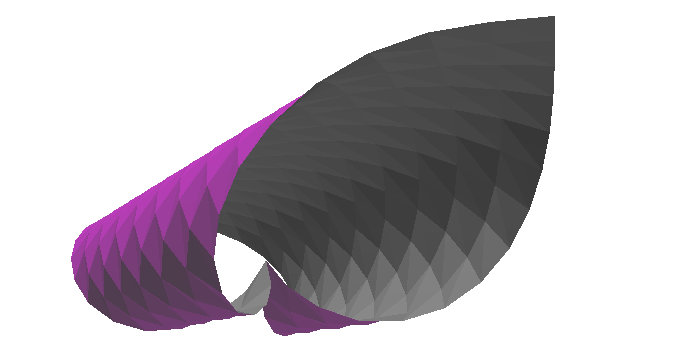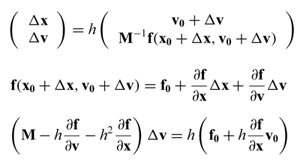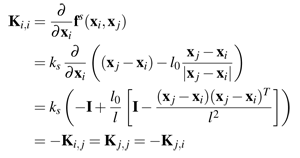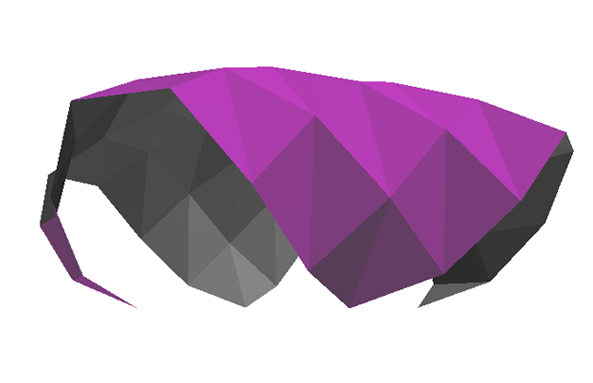Final Project: Shape of Paper Bending
Alan Song-Ching Tai

0425
What are the different approaches?
1.Simulation approach:
Use mass and spring system.
Use springs to simulate stretch, shear and bending.
The simulation need stiff springs. Try adopt backward Euler method for integration.
Compare to physical model and use search algorithm to find the right stiffness and configuration.
2.Geometric Surface approach:
Consider the surface of paper as developable surface.
Generate the rulings to discretize the surface. It is unclear how to the rulings can be generated.
Simulate the bending motion as rigid folding process. This process does not take into consideration of mechanics.
3.Finite Element approach
Meshing: Generate triangular surface element to cover the surface.
Paper bending might be similar to plate bending. However, Kirchoff-Love Plate theory does not apply to large deflection.
It is unclear how constraints can be added to simulate inextensible material.
Refrences:
[1] E. English and R. Bridson, "Animating developable surfaces using nonconforming elements," ACM Transactions on Graphics, vol. 27, no. 3, p. 1, 2008.
[2] O. Etzmuss, M. Keckeisen, and W. Strasser, "A fast finite element solution for cloth modelling," in Computer Graphics and Applications, 2003. Proceedings. 11th Pacific Conference on, 2003, p. 244–251.
[3]solidmechanics.org
[4] H. Gotoda, "Moving finite elements for simulating creasing phenomena of nearly unstretchable sheet materials," in Computer Animation 2000. Proceedings, 2000, p. 21–27.
0509
Mass and Spring System.
Advantages:
Largely used in cloth simulation. Paper simulation is similar to cloth simulation.
It is simple to implement.
It is computationally efficient.
Disadvantages:
The result is dependent on mesh resolution. The simulation does not converge.
It is hard to relate the spring constant to physical material properties.
It is possible to derive the quad network of mass and spring from continuum mechanics.
See paper "Deriving a particle system from continuum mechanics for the animation of deformable objects"by Etmuss et al[2].
Mass and spring system can be considered as elements with lumped mass. The elasticity constant of spring can be determined by comparing to the finite element method.
See paper "Determination of elasticity parameters in lumped element (mass-spring) models of deformable objects" by Natsupakpong[2].
References:
[1] A. Nealen, M. M\üller, R. Keiser, E. Boxerman, and M. Carlson, "Physically based deformable models in computer graphics," in Computer Graphics Forum, 2006, vol. 25, p. 809–836.
[2] O. Etzmuss, J. Gross, and W. Strasser, "Deriving a particle system from continuum mechanics for the animation of deformable objects," IEEE Transactions on Visualization and Computer Graphics, p. 538–550, 2003.
[3] S. Natsupakpong and M. Cenk Çavusoglu, "Determination of elasticity parameters in lumped element (mass-spring) models of deformable objects," Graphical Models, 2010.
0517
The programming environment is Python + Pygame + PyOpenGL.
Paper Simulation.
Connection of Mass and Spring[1]:

Non-Linear Bending Spring: Approximate the shape of bending using arcs.[1]

Integration: Euler, Runge-Kutta, Implicit Euler [2]

The partial derivative of force in spring is: [3]

The matrix construction:

Model with linear springs only:

Model with different conditions:
inextensible test - area variation-
model 1: 2.59%
model 2: 2.35%
model 3: 2.18%
model 4: 1.84%




References:
[1] K. J. Choi and H. S. Ko, "Stable but responsive cloth," in ACM SIGGRAPH 2005 Courses, 2005, p. 1–es.
[2] D. Baraff and A. Witkin, "Large steps in cloth simulation," in Proceedings of the 25th annual conference on Computer graphics and interactive techniques, 1998, p. 43–54.
[3]M.Muller, J.Stam, D.James, N. Thurey,"Real Time Physics Class Notes," Siggraph 2005










